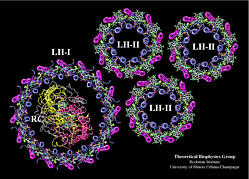Modeling the Structure of the Bacterial PSU

Arrangement of pigment protein complexes in the modeled bacterial photosynthetic unit (PSU) of Rb. sphaeroides .
The alpha-helices are represented as C-alpha-tracing tubes with
alpha-apoproteins of both LH-I and LH-II in
blue and beta-apoproteins in magenta, and the L, M, H subunits of RC in yellow, red, gray, respectively. All the bacteriochlorophylls are in green, and carotenoids in yellow. The figure has been produced with the program VMD
Click on the figure for a 167 kB version of the PSU
The PSU is a nanometric aggregate of many components and as such it poses an extreme challenge for structure analysis methods available today. The above figure presents a structural model of the PSU for the purple bacterium Rb. sphaeroides [R2] , [1], [2] . Shown is a top view of an (RC), surrounded by a (large) ring-like protein, the light harvesting complex I (LH-I) with a 16-fold symmetry axis, which in turn is surrounded by the light harvesting complex II (LH-II) with a nine-fold symmetry axis. Only three LH-IIs are shown. The actual photosynthetic apparatus can contain up to about nine LH-IIs around each LH-I. The unit has been constructed using the model structures of LH-I and LH-II of Rb. sphaeroides [3] , [2] , and the crystal structure of the RC of Rb. sphaeroides .
A two-step protocol had been developed and applied to modeling the three dimensional structures of LH-I and LH-II from Rb. sphaeroides . LH-I of Rb. sphaeroides had been modeled as a hexadecamer of alpha-beta-heterodimers [3] , which yields an electron density projection map that is in agreement with an 8.5 Angstrom resolution electron microscopy projection map for the highly homologous LH-I of Rs. rubrum. The alpha-beta-heterodimer of LH-I was constructed by means of homology modeling using the alpha-beta-heterodimer of LH-II of Rs. molischianum as a template, since genetic analysis shows that LH-II of Rs. molischianum is genetically the nearest to LH-I among all the LH-IIs for which sequences are available. LH-II from Rb. sphaeroides was modeled as a nanomer of alpha-beta-heterodimers. The alpha-beta-heterodimers of LH-II for Rb. sphaeroides were modeled through homology modeling based on the alpha-beta-heterodimer of LH-II from Rps. acidophila . The modeled LH-I has been docked to the photosynthetic reaction center of Rb. sphaeroides by means of a constrained conformational search [3] .



